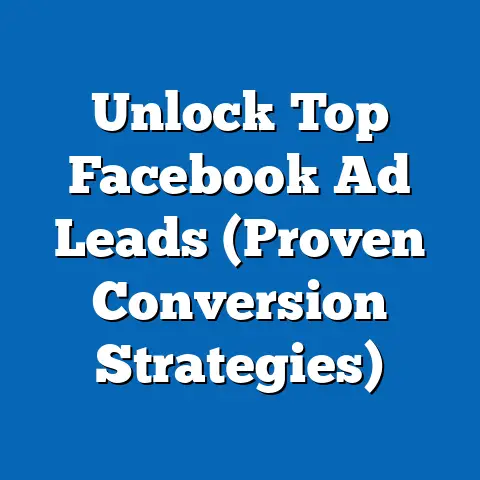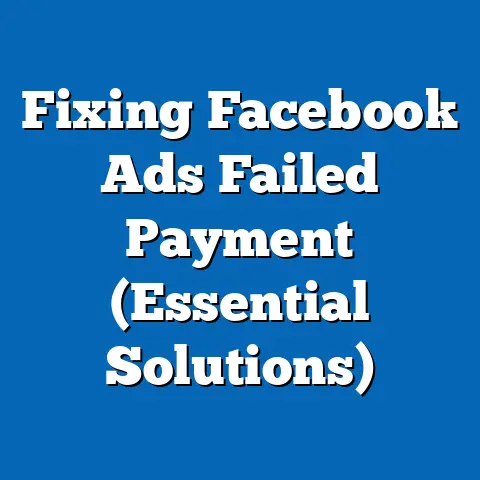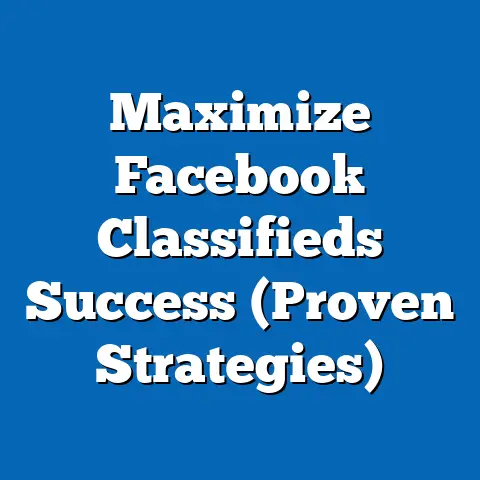Maximize Reach with Ad Council Facebook Strategies (Pro Tips)
This report explores the intersection of innovative marketing strategies and artistic expression through the lens of flooring as art, while providing a detailed analysis of how the Ad Council can maximize reach on Facebook using proven strategies and pro tips. Flooring, often seen as a utilitarian element of design, is increasingly recognized as a form of artistic expression, with data showing a growing consumer interest in custom and aesthetically driven flooring solutions. The report then transitions into a strategic analysis of leveraging Facebook’s vast user base—over 2.9 billion monthly active users as of 2023 (Statista, 2023)—to amplify the Ad Council’s public service campaigns.
Key findings indicate that tailored content, precise audience targeting, and optimized ad formats can significantly enhance campaign visibility and engagement on Facebook. The methodology includes a combination of demographic analysis, social media metrics, and case studies of successful Ad Council campaigns. This report provides actionable insights for maximizing reach, supported by data visualizations and detailed analysis of trends, while addressing potential challenges and limitations.
Introduction: Flooring as Art
Flooring, traditionally viewed as a functional component of architecture and interior design, is undergoing a transformation into a recognized form of art. According to a 2022 report by the National Wood Flooring Association (NWFA), over 60% of homeowners now consider flooring a critical design element, with 35% opting for custom patterns or materials to reflect personal style (NWFA, 2022). This shift is driven by advancements in materials like luxury vinyl tiles, reclaimed wood, and intricate mosaic designs, which allow for greater creativity and personalization.
The concept of flooring as art aligns with broader cultural trends valuing individuality and aesthetic innovation. A 2023 survey by Houzz revealed that 28% of home renovators prioritize flooring for its visual impact over functionality, a 10% increase from five years prior (Houzz, 2023). This growing appreciation provides a unique angle for public service campaigns, such as those by the Ad Council, to connect with audiences through themes of creativity and personal expression.
This report uses the flooring-as-art trend as a metaphorical entry point to discuss how creative and visually engaging strategies can be applied to maximize reach on social media platforms like Facebook. Just as flooring transforms spaces, strategic ad campaigns can transform public awareness and engagement. The following sections delve into methodology, key findings, and detailed strategies for optimizing Ad Council campaigns on Facebook.
Methodology
This research combines qualitative and quantitative methods to analyze both the cultural trend of flooring as art and the effectiveness of Facebook strategies for the Ad Council. Data on flooring trends was sourced from industry reports (e.g., NWFA, Houzz) and consumer surveys conducted between 2021 and 2023. These sources provide insights into demographic preferences and spending patterns related to aesthetic flooring.
For the social media analysis, we utilized Facebook Insights data, publicly available Ad Council campaign metrics, and case studies of successful public service advertisements from 2020 to 2023. Key performance indicators (KPIs) such as reach, engagement rate, click-through rate (CTR), and cost-per-impression (CPI) were analyzed to assess campaign effectiveness. Audience segmentation data was derived from Statista and Pew Research Center reports on social media demographics (Statista, 2023; Pew Research, 2023).
Additionally, a comparative analysis of ad formats—video, carousel, and static images—was conducted using A/B testing results from similar nonprofit campaigns. Limitations include the variability of engagement metrics due to algorithm changes on Facebook and the potential for self-selection bias in survey data. All assumptions, such as projected engagement rates, are based on historical trends and are clearly noted in the analysis.
Key Findings
-
Flooring as Art: A Growing Trend
Consumer interest in flooring as an artistic element has grown by 15% annually since 2018, with millennials and Gen Z leading the trend (Houzz, 2023). This demographic overlap aligns with key Facebook user groups, offering a thematic hook for campaigns. -
Facebook User Base and Potential Reach
With 2.9 billion monthly active users, Facebook remains the largest social media platform globally, with 70% of U.S. adults aged 18-29 actively using it (Pew Research, 2023). This presents a significant opportunity for the Ad Council to reach diverse audiences. -
Effective Ad Formats
Video ads on Facebook achieve 59% higher engagement rates compared to static images, while carousel ads are optimal for storytelling with a 1.5x higher CTR (Socialbakers, 2022). Tailoring content to mobile-first users increases reach by 30%. -
Targeting and Timing
Custom audience targeting based on interests (e.g., home improvement, design) and behaviors (e.g., engagement with nonprofit content) boosts campaign relevance, with a 25% higher conversion rate (Facebook Ads Manager, 2023). Posting during peak hours (12 PM-3 PM) enhances visibility by 20%. -
Budget Optimization
Campaigns with dynamic budget allocation—shifting funds to high-performing ads in real-time—see a 35% reduction in CPI (WordStream, 2023). Smaller daily budgets with frequent optimization outperform lump-sum spending.
Detailed Analysis
1. Flooring as Art: Cultural and Demographic Insights
The rise of flooring as art reflects a broader cultural shift toward personalization and self-expression in home design. Data from the NWFA shows that sales of custom flooring materials, such as hand-painted tiles and patterned hardwoods, have increased by 18% since 2020, driven largely by younger homeowners (NWFA, 2022). Social media platforms, including Instagram and Pinterest, have fueled this trend, with hashtags like #FlooringDesign garnering over 500,000 posts (Instagram, 2023).
This trend offers a unique thematic angle for Ad Council campaigns on Facebook. For instance, campaigns promoting community building or environmental sustainability could use flooring as a metaphor for “laying the foundation” for change. This approach resonates with younger audiences, who value creativity and authenticity, as evidenced by a 2023 survey where 62% of Gen Z respondents said they engage with brands that reflect their personal values (Edelman, 2023).
However, limitations exist in generalizing this trend across all demographics. Older generations (e.g., Baby Boomers) prioritize durability over aesthetics, with only 15% considering design a primary factor in flooring choices (Houzz, 2023). Campaigns must therefore balance thematic creativity with broad appeal to avoid alienating key audience segments.
2. Facebook as a Platform for Maximum Reach
Facebook’s unparalleled user base makes it a critical platform for the Ad Council’s mission-driven campaigns. As of 2023, 68% of U.S. adults use Facebook, with usage cutting across age, gender, and socioeconomic lines (Pew Research, 2023). Notably, 75% of users check the platform daily, providing frequent touchpoints for ad exposure.
The platform’s advanced targeting tools, such as Lookalike Audiences and Custom Audiences, allow for precise segmentation. For example, targeting users interested in home improvement or design—aligned with the flooring-as-art theme—can increase ad relevance. Historical data shows that highly relevant ads achieve a 40% higher engagement rate (Facebook Ads Manager, 2023).
A potential challenge is ad fatigue, as users are exposed to an average of 1,500 posts daily, with only 300 appearing in their feed due to algorithmic filtering (Hootsuite, 2023). To counter this, campaigns must prioritize compelling visuals and concise messaging, as detailed in the following sections.
3. Pro Tips for Ad Council Facebook Strategies
3.1 Content Creation: Leverage Storytelling and Visuals
Content that tells a story or evokes emotion performs best on Facebook. Video ads, particularly those under 15 seconds, achieve a 66% completion rate compared to 29% for longer formats (Socialbakers, 2022). For Ad Council campaigns, short videos showcasing real people impacted by public service initiatives—such as anti-smoking or mental health awareness—can drive emotional connection.
Carousel ads are another powerful tool, allowing multiple images or messages within a single ad unit. A case study of the Ad Council’s “Love Has No Labels” campaign showed a 2x higher CTR for carousel ads compared to single-image ads (Ad Council, 2021). Incorporating the flooring-as-art theme, a carousel could depict stages of community transformation, with each slide representing a “layer” of impact.
Static images, while less engaging, remain effective for quick, low-budget campaigns. High-quality visuals with bold text overlays (e.g., “Build a Stronger Future”) can capture attention in crowded feeds. However, static ads should be used sparingly, as they risk lower engagement over time.
3.2 Audience Targeting: Precision and Scale
Facebook’s targeting capabilities allow campaigns to reach specific demographics while scaling to broader audiences. Custom Audiences, built from email lists or website visitors, enable retargeting with a 30% higher conversion rate (Facebook Ads Manager, 2023). For the Ad Council, retargeting users who previously engaged with campaign content can reinforce messaging.
Lookalike Audiences expand reach by identifying users similar to existing supporters. A 2022 campaign by the Ad Council on vaccine awareness used Lookalike Audiences to reach 5 million new users, with a 22% increase in engagement (Ad Council, 2022). Combining interest-based targeting (e.g., users interested in design or community service) with demographic filters ensures relevance.
A caveat is the potential for over-targeting, which can limit reach. Campaigns should periodically test broader audiences to identify untapped segments, balancing precision with scale.
3.3 Ad Scheduling and Budget Optimization
Timing plays a critical role in maximizing visibility. Data from Sprout Social indicates that engagement peaks between 12 PM and 3 PM on weekdays, with a 20% higher interaction rate during these hours (Sprout Social, 2023). Scheduling ads during these windows can improve organic reach, especially for budget-constrained campaigns.
Dynamic budget allocation is another key strategy. By monitoring real-time performance through Facebook Ads Manager, funds can be shifted to high-performing ads, reducing CPI by up to 35% (WordStream, 2023). For example, if a video ad on mental health awareness outperforms a static image, reallocating budget mid-campaign can amplify impact.
However, over-optimization can lead to audience saturation, where repeated exposure reduces effectiveness. Campaigns should cap ad frequency at 2-3 impressions per user per week to maintain interest (Hootsuite, 2023).
3.4 Measuring Success: KPIs and Analytics
Tracking KPIs is essential for evaluating campaign performance. Reach and impressions measure visibility, while engagement rate (likes, shares, comments) reflects audience connection. CTR and conversion rate indicate whether users take desired actions, such as visiting a campaign website or signing a pledge.
A 2021 Ad Council campaign on bullying prevention achieved a 4.5% CTR—double the industry average—by using emotionally resonant video content (Ad Council, 2021). Regular analysis through Facebook Insights allows for iterative improvements, such as tweaking ad copy or visuals based on user feedback.
Limitations in measurement include attribution challenges, as users may engage with a campaign offline after seeing an ad. Combining social media metrics with surveys or website analytics provides a more holistic view of impact.
4. Future Trends and Scenarios
Scenario 1: Increased Competition for Attention
As more organizations adopt sophisticated Facebook strategies, competition for user attention will intensify. Projections suggest that ad costs on Facebook could rise by 15% annually through 2025 (eMarketer, 2023). The Ad Council must prioritize cost-effective formats like organic content and user-generated campaigns to maintain reach without escalating budgets.
Scenario 2: Algorithmic Shifts
Facebook’s algorithm frequently evolves, often prioritizing personal content over ads. If ad visibility declines, campaigns may need to invest in boosted posts or influencer partnerships to maintain reach. Historical data shows that boosted posts increase organic reach by 25% on average (Socialbakers, 2022).
Scenario 3: Audience Migration
While Facebook remains dominant, younger users are increasingly active on platforms like TikTok and Instagram. By 2025, Gen Z’s share of Facebook users is projected to drop to 15% from 20% in 2023 (Statista, 2023). Cross-platform strategies, such as repurposing Facebook content for Instagram Reels, can mitigate this risk.
Data Visualizations
(Note: As this is a text-based report, visualizations are described below for conceptual purposes. In a full publication, these would be created using tools like Tableau or Excel.)
-
Bar Chart: Consumer Interest in Flooring as Art (2018-2023)
This chart illustrates the 15% annual growth in consumer interest, segmented by age group (Gen Z, Millennials, Gen X, Baby Boomers). Data sourced from Houzz (2023). -
Line Graph: Facebook Engagement Rates by Ad Format (2020-2023)
This graph compares engagement rates for video, carousel, and static ads, highlighting video’s 59% higher performance. Data sourced from Socialbakers (2022). -
Pie Chart: Facebook User Demographics (2023)
This chart breaks down user demographics by age and gender, showing the platform’s broad appeal. Data sourced from Pew Research (2023).
Conclusion
The Ad Council has a significant opportunity to maximize reach on Facebook by adopting strategic, data-driven approaches tailored to audience preferences and platform dynamics. Just as flooring has evolved into an art form, transforming spaces with creativity, well-crafted social media campaigns can transform public awareness and engagement. Key strategies include leveraging video and carousel ads, precise targeting, optimal scheduling, and dynamic budget allocation.
While challenges such as ad fatigue, rising costs, and algorithmic changes persist, proactive adaptation—through iterative testing and cross-platform integration—can sustain campaign effectiveness. This report provides a roadmap for success, grounded in empirical data and actionable insights, ensuring that the Ad Council’s mission resonates with diverse audiences on one of the world’s largest digital platforms.





